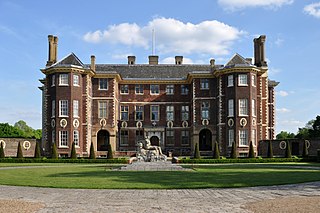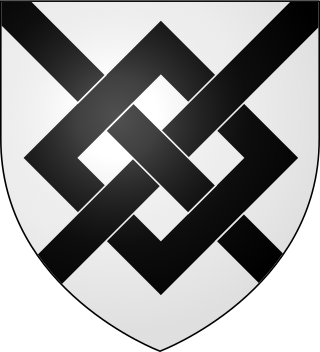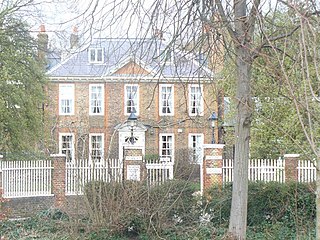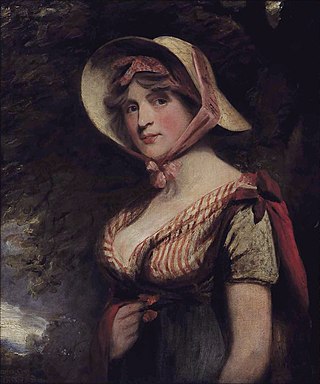
Petersham is a village in the London Borough of Richmond upon Thames on the east of the bend in the River Thames south of Richmond, which it shares with neighbouring Ham. It provides the foreground of the scenic view from Richmond Hill across Petersham Meadows, with Ham House further along the river. Other nearby places include Twickenham, Isleworth, Teddington, Mortlake, and Roehampton.

Ham House is a 17th-century house set in formal gardens on the bank of the River Thames in Ham, south of Richmond in the London Borough of Richmond upon Thames. The original house was completed in 1610 by Thomas Vavasour, an Elizabethan courtier and Knight Marshal to James I. It was then leased, and later bought, by William Murray, a close friend and supporter of Charles I. The English Civil War saw the house and much of the estate sequestrated, but Murray's wife Katherine regained them on payment of a fine. During the Protectorate his daughter Elizabeth, Countess of Dysart on her father's death in 1655, successfully navigated the prevailing anti-royalist sentiment and retained control of the estate.

Ham is a suburban district in Richmond, south-west London. It has meadows adjoining the River Thames where the Thames Path National Trail also runs. Most of Ham is in the London Borough of Richmond upon Thames and, chiefly, within the ward of Ham, Petersham and Richmond Riverside; the rest is in the Royal Borough of Kingston upon Thames. The district has modest convenience shops and amenities, including a petrol station and several pubs, but its commerce is subsidiary to the nearby regional-level economic centre of Kingston upon Thames.

Span Developments Limited was a British property development company formed in the late 1950s by Geoffrey Townsend working in long and close partnership with Eric Lyons as consultant architect. During its most successful period in the 1960s, Span built over 2,000 homes in London, Surrey, Kent and East Sussex – mainly two- and three-bedroom single-family homes and apartment buildings.
Algernon Gray Tollemache was a British gentleman and politician. He was the sixth and youngest son of William Tollemache, Lord Huntingtower and Catherine Gray.

The Tollemache family is an English noble family, originally from Suffolk. The family's surname is pronounced TOL-mash.
William John Manners Tollemache, 9th Earl of Dysart DL in the Peerage of Scotland, was also a Baronet (cr.1793) in the Baronetage of Great Britain, Lord Lieutenant of Rutland (1881–1906), and Justice of the Peace for Leicestershire and Lincolnshire.

Ormeley Lodge is a Grade II* listed early 18th-century Georgian house, set in 6 acres (2 ha) on the edge of Ham Common, near to Richmond Park in Ham, London. It is owned by Lady Annabel Goldsmith.

St Peter's Church is the parish church of the village of Petersham in the London Borough of Richmond upon Thames. It is part of the Diocese of Southwark in the Church of England. The main body of the church building dates from the 16th century, although parts of the chancel date from the 13th century, and evidence in Domesday Book suggests that there may have been a church on the site in Saxon times. Nikolaus Pevsner and Bridget Cherry describe it as a "church of uncommon charm... [whose] interior is well preserved in its pre-Victorian state". The church, which is Grade II* listed, includes Georgian box pews, a two-decker pulpit made in 1796, and a display of the royal arms of the House of Hanover, installed in 1810. Its classical organ was installed at the south end in late 2009 by the Swiss builders Manufacture d'Orgues St Martin of Neuchâtel, and a separate parish room was added in 2018. Many notable people are buried in the churchyard, which includes some Grade II-listed tombs.
The Petersham Hole was a sink hole caused by subsidence of a sewer which forced the total closure of the A307 road in Petersham in the London Borough of Richmond upon Thames in 1979–80. It caused long-term disruption to traffic in the surrounding area and significant direct and indirect costs.

Elizabeth Maitland, Duchess of Lauderdale, 2nd Countess of Dysart, was a Scottish noblewoman. She was the eldest daughter of William Murray and his wife Catherine, the Earl and Countess of Dysart. She was raised in English court circles during the years leading up to the English Civil War and received a well-rounded education from her parents. Her first husband was Lionel Tollemache, with whom she had eleven children. In 1672, three years after Lionel's death, she married John Maitland and gained a prominent position in the restored court.

Joan Carlile or Carlell or Carliell, was an English portrait painter. She was one of the first British women known to practise painting professionally. Before Carlile, known professional female painters working in Britain were born elsewhere in Europe, principally the Low Countries.

Sudbrook Park in Petersham was developed by John Campbell, 2nd Duke of Argyll in the early 18th century. Sudbrook House, designed for Argyll by James Gibbs and now Grade I listed by Historic England, is considered a fine example of Palladian architecture. The house and its surrounding park have been the home of the Richmond Golf Club since 1891.

Canbury is a district of the northern part of Kingston upon Thames that takes its name from the historic manor that covered the area. Modern Canbury comprises two electoral wards in the constituency of Richmond Park; Canbury Ward to the south and Tudor Ward to the north.

Ham Common is an area of common land in Ham, London. It is a conservation area in, and managed by, the London Borough of Richmond upon Thames. It comprises 48.69 hectares, the second largest area of common land in the borough, 2 acres (0.81 ha) smaller than Barnes Common. It is divided into two distinct habitats, grassland and woodland, separated by the A307, Upper Ham Road. It is an area of ecological, historical and recreational interest, designated a Local Nature Reserve.

Douglas House is a Grade II* listed early 18th-century Queen Anne-style house in Petersham in the London Borough of Richmond upon Thames. It is now the site of the German School London.

Louisa Manners Tollemache, 7th Countess of Dysart was a peer in the Scottish peerage in a flourishing family. Her father held considerable estates in England largely due to the two marriages of Elizabeth Maitland, Duchess of Lauderdale, earlier Tollemache, née Elizabeth Murray. Her elder brothers left no surviving issue on their deaths which enabled her to enjoy and help to pass on to her descendants the key family settlement properties: Helmingham Hall and Ham House in England.

Sir Lyonel Felix Carteret Eugene Tollemache, 4th Baronet was an English landowner.

Langham House is a Grade II-listed house facing Ham Common in the London Borough of Richmond upon Thames. It was built in about 1709 and former home of several notable residents.


















